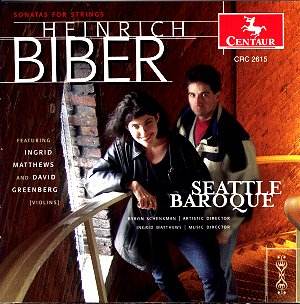This
CD is a well-chosen sample of Biberís finest ensemble music. One
of the supreme violinists and virtuoso composers of the 17th
century, much of Biber's work remains underplayed and relatively
obscure. However, as Burnley wrote, over 100 years after many
of the pieces on this disc were composed, Ďof all the violin players
of the last century Biber seems to have been the best, and his
solos are the most difficult and most fanciful of any music I
have seen of the same periodí.
Seattle
Baroque, a highly regarded ensemble, formed in 1994, present well-paced,
elegant readings of these wonderful sonatas. I would not hesitate
in recommending this disc to newcomers to Biber, who Iím sure
will be swept away by the sheer inventiveness of this music. One
only has to listen to Sonata IX (track 2), for example,
to be confronted with a seemingly endless number of melodic ideas
tumbling over each other. This is music that rewards repeated
listening; there are so many unexpected alterations in rhythm
and texture throughout these pieces that it takes some effort
to warm to them.
Although
I am impressed with the recording as a whole, there are a number
of shortcomings. The first concerns the recording quality, which
I find overly brittle, and at times painfully close. I found myself
turning the bass up and the treble down to compensate. The balance
favours the violins (perhaps not surprisingly), but to the detriment
of the harpsichord, which is needed to bring a required richness
to the sound. This is particularly unfortunate, given that Schenkman
is a very fine player indeed. The violins themselves generate
quite different tones. Matthews plays an original from 1703, while
those of Greenberg and Cresswell are modern copies, and there
are times when they donít quite gel, particularly in the high
registers (most noticeably in Sonata XI).
Perhaps
the most engaging composition on the disc is the Sonata a sei
in B-flat "Die Pauernkirchfahrt". After a simple
adagio, an extended section of call and echo among the strings
gradually fades to nothing before a new ascending, then descending,
graceful motif is played out. Itís performed in a thoughtful,
measured style and works beautifully.
Following
this, we have the first of two anonymous keyboard partitas dating
from the late 17th century Göttweig manuscript.
The harpsichord sounds wonderful here and the piece is superb.
A very pretty allemande is followed by a brusque courante, then
a series of short airs and variations, followed by a gigue. Schenkman
takes a no nonsense approach to the music, with little ornamentation,
and the result is very exciting.
The
other keyboard partita is equally impressive, and is played with
great confidence. Some may wish for a more rhythmically free style
of playing (Schenkman here reminds me of Trevor Pinnock in his
recent Bach solo recordings), but it is never less than involving.
Including these two keyboard works was a masterstroke and complements
the ensemble pieces.
Of
the other works, Sonata VIII is one of the most enjoyable
on the disc. It has an irresistible forward momentum which does
not let up. Technically very demanding, it is played at quite
a fast tempo with top notch performances all round.
Caveats
aside, this is a warmly recommended release and a fine introduction
to Biberís writing for ensemble. Packaging is just about adequate,
although track descriptions are incomplete.
Peter
Bright

